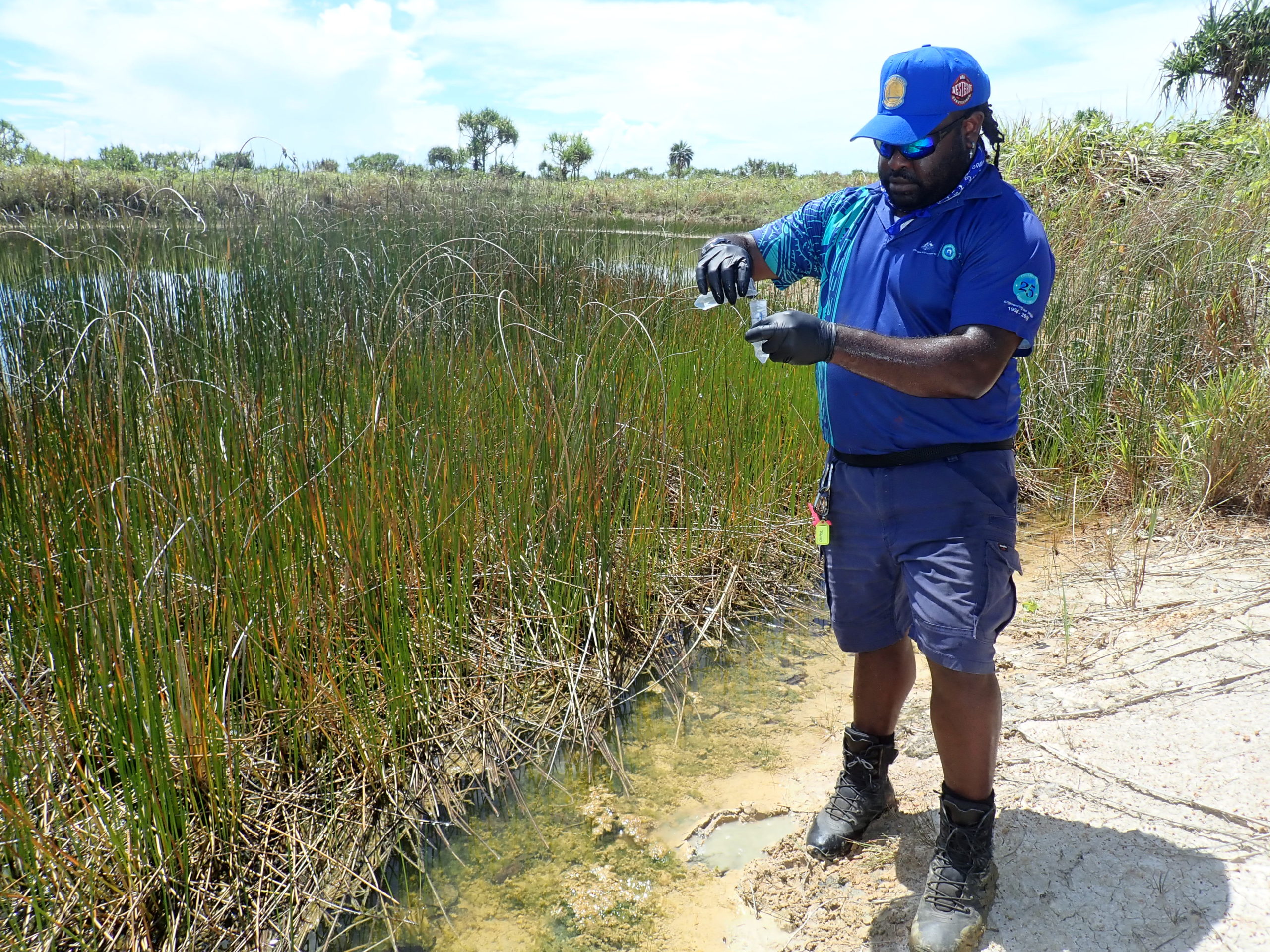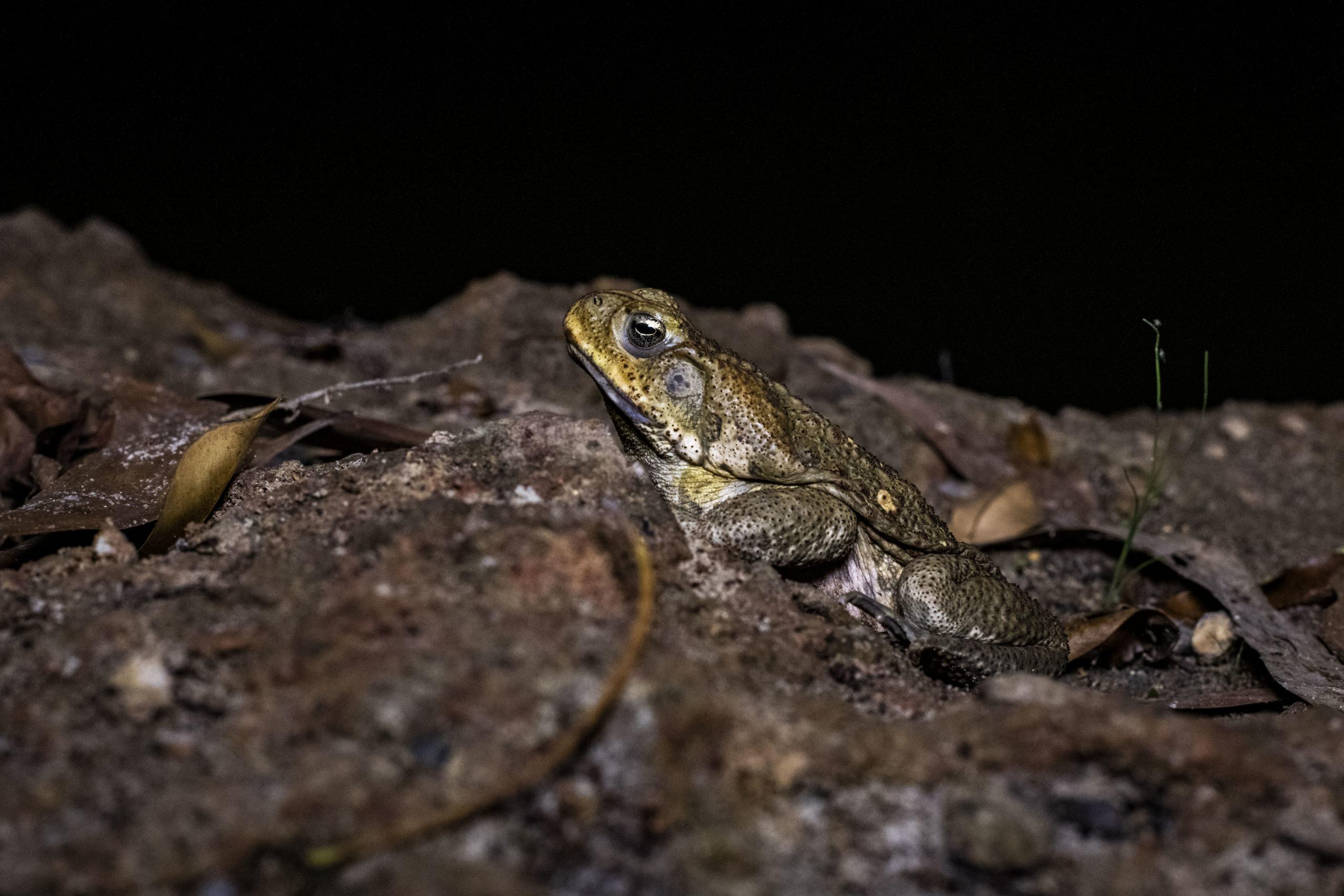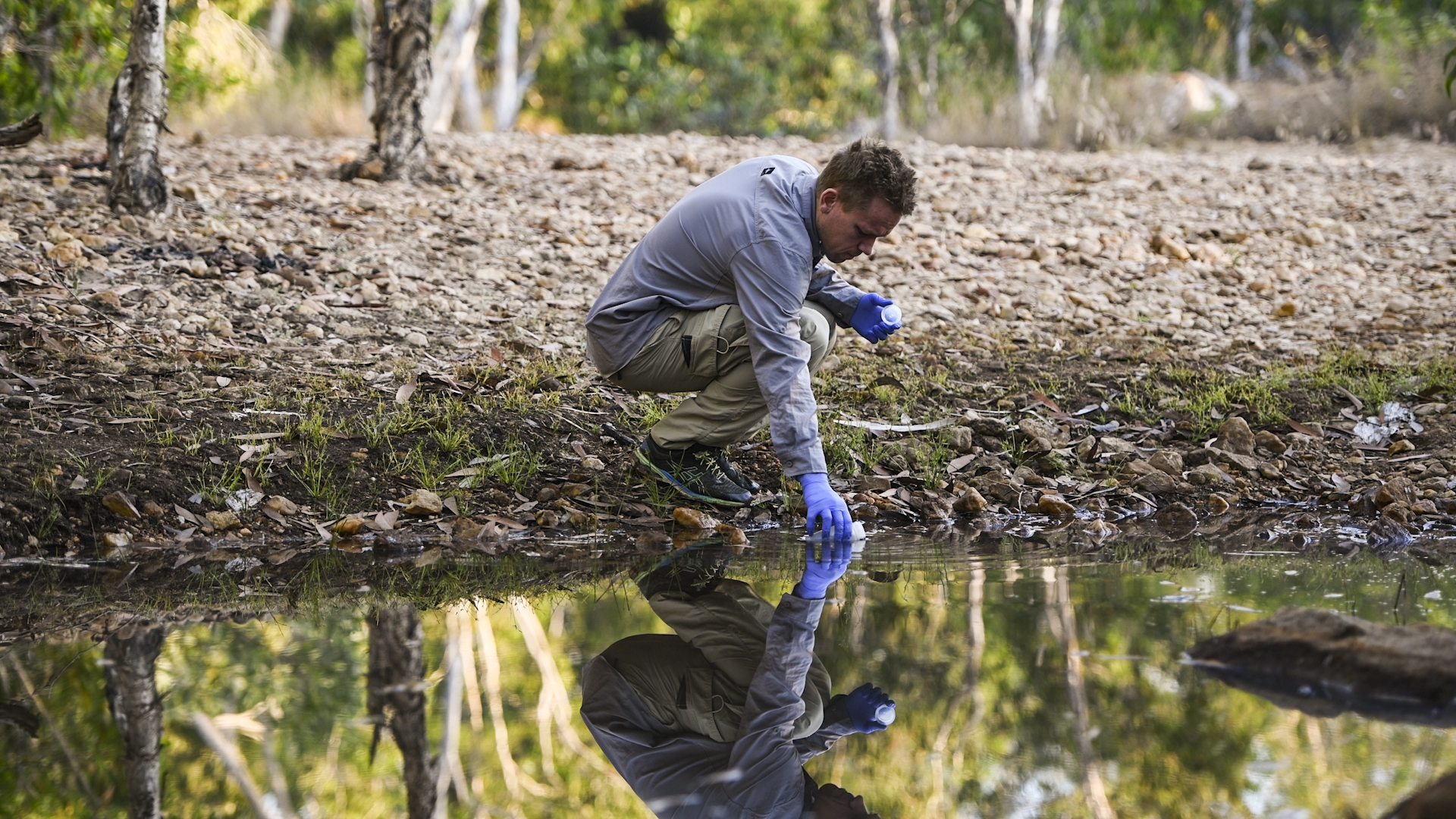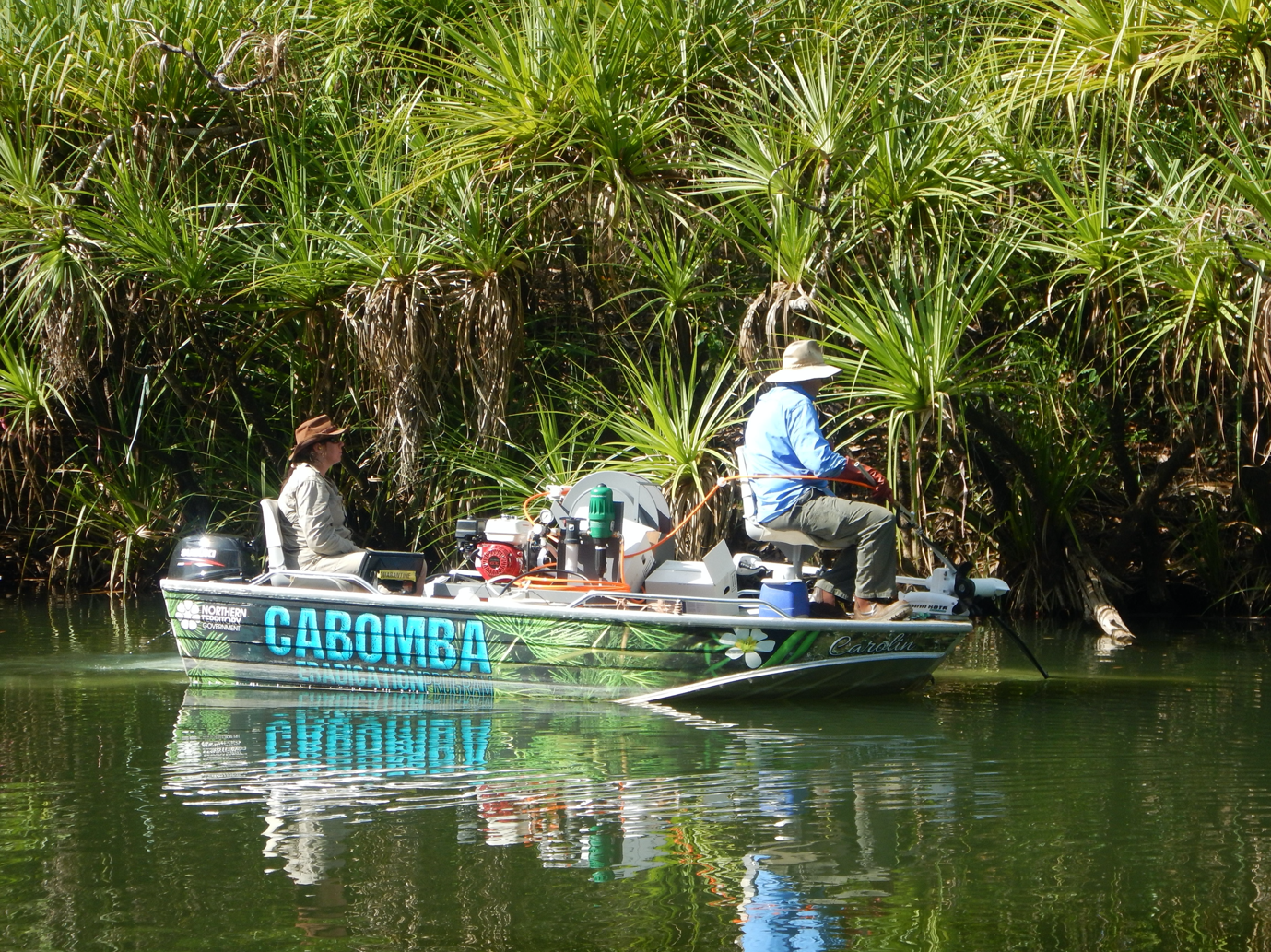How do you manage an invasive species that can spread across the landscape from waterhole to waterhole? The first step is knowing where they are. Cane toads have become a major problem species in northern Australia in recent years. They continue to expand across the north and are lethal to many native animals. But using an environmental DNA (eDNA) test developed by Hub researchers, we can tell if cane toads have visited a waterhole for as little as five minutes. The power of this eDNA method of detection means that cryptic or rare organisms can be detected without being directly observed, and waterbodies can be sampled comparatively quickly and in the daylight to minimise the risk to those monitoring invasive threats across northern Australia.

Torres Strait Regional Authority, Land and Sea Management Unit Mura Buway Ranger Jehemess Waia collecting eDNA samples from Saibai water body. Photo by Torres Strait Regional Authority 2020.
Cane toads (Rhinella marina) are a toxic and extremely invasive pest. They are lethal to many of Australia’s native animals, particularly predators such as the Northern Quoll and large reptiles including goannas. Cane toads have spread throughout Queensland and the Northern Territory (NT), and are advancing through northern Western Australia. They will soon occupy nearly two million square kilometres of land.
Not only are cane toads widely dispersed across the landscape, the habitats through which cane toads are spreading can be remote and hazardous for monitoring and management. Night-time spotlight surveys, sound detection and trapping have previously been the primary methods of detection, but all of these allow cane toads to ‘slip through the gaps’ when they are at low densities, such as on the invasion front currently advancing through Western Australia’s Kimberley region.
Improving the ability to detect cane toads increases the chance of identifying new cane toad incursions and improves the management efficiency and safety of those monitoring and managing cane toads.

Hub researchers from James Cook University (JCU) have found that environmental DNA (eDNA) can be used to detect the presence of a single cane toad from the first day after it arrives at a new location, even if it only visited a waterbody for as little as five minutes.
Tracking the arrival of cane toads into a new area is a challenge. They are active at night, and the low number of cane toads at the invasion front means they are difficult to detect using traditional survey methods that rely on either seeing, hearing or catching an animal.
– Dr Cecilia Villacorta-Rath, James Cook University
Using eDNA is a more efficient way to keep track of cane toads, rather than searching for them at night in remote conditions. Project leader Professor Damien Burrows of JCU explains that cane toads don’t live in the waterholes they visit, but they do have to visit a water source every day to hydrate.
The average time it takes for a cane toad to hydrate is five minutes. We wanted to know if we could use eDNA to detect a single cane toad that might visit a waterbody for five minutes and then leave.
– Professor Damien Burrows, Project Leader, James Cook University

We can track the invasion of cane toads by collecting a water sample from small ponds and puddles during the day. Photo by NESP Northern Hub.
The researchers conducted experiments in 200- and 800-litre tanks of freshwater to replicate the small waterbodies that cane toads visit to hydrate to determine how long does it take to detect the cane toad signal. Due to the conditions across northern Australia, where cane toads are a particular concern, the researchers also tested how long their eDNA persists in water of 25, 30 and 35 degrees Celsius.
The results indicated that even though eDNA decays rapidly in waterbodies, it can be reliably detected three days after cane toads have visited – regardless of the temperature. The persistence of eDNA in small, hot waterbodies means that this test can be particularly useful on the front lines of expanding cane toad populations.
Managing or eradicating an invasive species is always challenging, but the likelihood of success increases when populations are small and individuals aren’t ubiquitous across the landscape.
The project team has also validated these experiments with field testing. JCU researchers obtained Traditional Owner approval to conduct trials at sites in northern Queensland. The Land and Sea Management Unit Rangers from the Torres Strait Regional Authority supported researchers with the collection of eDNA samples from community water sources on Badu, Saibai, Erub and Boigu Islands. TSRA is building on these trials through funding from the Queensland Government’s Natural Resources Investment Program for the collection of additional water samples to complement JCU field testing and regional invasive species monitoring.
JCU researchers have developed a long-standing partnership with the TSRA over many years. These two-way connections provide researchers with insight into localised knowledge across Torres Strait communities and provided these communities with innovative monitoring and management techniques.
TSRA sees continuing value in our partnership with JCU. JCU researchers have shown commitment in delivering training to Rangers and sharing results with Traditional Owners for their use in local land and sea management.
– Mr Napau Pedro Stephen AM, Torres Strait Regional Authority Chairperson
TSRA Chairperson Mr Napau Pedro Stephen AM said the technique is already helping them monitor cane toads.
Indigenous rangers collect water samples from islands across the Torres Strait which we send to JCU to test for cane toad DNA. We are trying to stop cane toads from reaching the outer islands so being able to tell from a water sample whether a cane toad has been in a creek is another tool in our efforts to stop the spread of toads.
– Mr Napau Pedro Stephen AM
This validated test will be useful for existing managers who are combatting the spread of cane toads, but could also provide opportunities for Indigenous rangers and citizen scientists to help track the invasion of cane toads.
eDNA testing is an efficient tool that can easily and safely monitor for the absence or presence of cane toads, as well as providing supplementary data for cane toad monitoring and incursion surveys.
– Mr Napau Pedro Stephen AM

Cabomba eradication boat, Northern Territory Government, photo Christopher J. Collins.
The project team has also been working on tests to help manage other invasive species across northern Australian waterways.
Mozambique (Oreochromis mossambicus) and spotted (Tilapia mariae) tilapia are two aggressive species of fish that were introduced into Queensland waterways through the aquarium trade. Both species are steadily expanding their range and Hub research is helping to closely monitor and manage this spread.
Researchers developed a first test for tilapia in the early 2010s but have since refined the test so that it is better able to detect both tilapia species. Increasing the power of this test so that both species are equally detectable ensures that waterway managers have the best possible chance of detecting and combatting the spread of these invasive species.
Although aquatic plants might not seem as elusive as animals that can move around or through waterways, some weeds can cause significant ecosystem damage while remaining unnoticed and we need tests to monitor where they are spreading. Cabomba (Cabomba caroliniana) is one such invasive weed that can choke up waterways across northern Australia.
Cabomba can substantially affect water quality, and NT Power and Water estimated that it would cost between $60 and $80 million to build a water treatment plant to make Darwin’s water supply drinkable if cabomba got into Darwin River Dam.
– Mr Chris Collins, Northern Territory Government
The JCU research team has been working with NT Government staff to equip them with an additional detection method for their toolkit – a further insurance layer to prevent outbreaks of a really damaging weed.
Currently, none of our detection methods are 100% effective, so any additional technique we have that can tell us whether cabomba might be in the waterbody or not is certainly useful to us.
– Mr Chris Collins
As we continue to refine eDNA tests for invasive species across northern Australia, land managers will have incredibly useful tools to help them eradicate or contain invasive plants and animals in the vast landscapes that they maintain.
The power of this eDNA method of detection means that cryptic or rare organisms can be detected without being directly observed, and waterbodies can be sampled comparatively quickly and in the daylight to minimise the risk to those monitoring invasive threats across northern Australia.
Research outputs
Scientific papers
Media (selection) – cane toad story
Reports
Factsheets
Project webpage
Attributions
We acknowledge Aboriginal and Torres Strait Islander Peoples as the traditional custodians of the lands on which we work. We pay our respects to Elders of the past and present, and acknowledge their spiritual connection to Country. In particular we would like to acknowledge the Torres Strait Island, Larrakia, Wulgurukaba and Bindal people of the regions where this project took place.